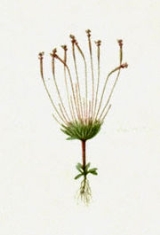
Stylidium pedunculatum
Encyclopedia
Stylidium pedunculatum is a dicotyledon
ous plant
that belongs to the genus
Stylidium (family Stylidiaceae
). It is an annual plant
that grows from 5 to 10 cm tall. The linear
or deltate leaves, about 20-200 per plant, are mostly in terminal rosettes
but with some scattered along the elongate stem. The leaves are generally 4.5-8.5 mm long and 0.5-0.8 mm wide. Petioles
are absent. This species produces 2-14 scapes
per plant. Inflorescence
s are 4-7 cm long and produces a single white or pink flower that blooms from March to September in the southern hemisphere
. S. pedunculatums distribution is scattered in the tropical areas of Queensland
and the Northern Territory
and isolated in the Aru Islands
. Its habitat is recorded as being damp, sandy soils in open Melaleuca viridiflora
communities. It's been found in association with Drosera, Schoenus
, and Utricularia species. S. pedunculatum is most closely associated with S. ericksoniae
. Its conservation status
has been assessed as data deficient
.
Dicotyledon
The dicotyledons, also known as dicots, are a group of flowering plants whose seed typically has two embryonic leaves or cotyledons. There are around 199,350 species within this group...
ous plant
Plant
Plants are living organisms belonging to the kingdom Plantae. Precise definitions of the kingdom vary, but as the term is used here, plants include familiar organisms such as trees, flowers, herbs, bushes, grasses, vines, ferns, mosses, and green algae. The group is also called green plants or...
that belongs to the genus
Genus
In biology, a genus is a low-level taxonomic rank used in the biological classification of living and fossil organisms, which is an example of definition by genus and differentia...
Stylidium (family Stylidiaceae
Stylidiaceae
The family Stylidiaceae is a taxon of dicotyledonous flowering plants. It consists of five genera with over 240 species, most of which are endemic to Australia and New Zealand. Members of Stylidiaceae are typically grass-like herbs or small shrubs and can be perennials or annuals...
). It is an annual plant
Annual plant
An annual plant is a plant that usually germinates, flowers, and dies in a year or season. True annuals will only live longer than a year if they are prevented from setting seed...
that grows from 5 to 10 cm tall. The linear
Leaf shape
In botany, leaf shape is characterised with the following terms :* Acicular : Slender and pointed, needle-like* Acuminate : Tapering to a long point...
or deltate leaves, about 20-200 per plant, are mostly in terminal rosettes
Rosette (botany)
In botany, a rosette is a circular arrangement of leaves, with all the leaves at a single height.Though rosettes usually sit near the soil, their structure is an example of a modified stem.-Function:...
but with some scattered along the elongate stem. The leaves are generally 4.5-8.5 mm long and 0.5-0.8 mm wide. Petioles
Petiole (botany)
In botany, the petiole is the stalk attaching the leaf blade to the stem. The petiole usually has the same internal structure as the stem. Outgrowths appearing on each side of the petiole are called stipules. Leaves lacking a petiole are called sessile, or clasping when they partly surround the...
are absent. This species produces 2-14 scapes
Scape (botany)
In botany, scapes are leafless flowering stems that rise from the ground. Scapes can have a single flower or many flowers, depending on the species....
per plant. Inflorescence
Inflorescence
An inflorescence is a group or cluster of flowers arranged on a stem that is composed of a main branch or a complicated arrangement of branches. Strictly, it is the part of the shoot of seed plants where flowers are formed and which is accordingly modified...
s are 4-7 cm long and produces a single white or pink flower that blooms from March to September in the southern hemisphere
Southern Hemisphere
The Southern Hemisphere is the part of Earth that lies south of the equator. The word hemisphere literally means 'half ball' or "half sphere"...
. S. pedunculatums distribution is scattered in the tropical areas of Queensland
Queensland
Queensland is a state of Australia, occupying the north-eastern section of the mainland continent. It is bordered by the Northern Territory, South Australia and New South Wales to the west, south-west and south respectively. To the east, Queensland is bordered by the Coral Sea and Pacific Ocean...
and the Northern Territory
Northern Territory
The Northern Territory is a federal territory of Australia, occupying much of the centre of the mainland continent, as well as the central northern regions...
and isolated in the Aru Islands
Aru Islands
The Aru Islands are a group of about ninety-five low-lying islands in the Maluku province of eastern Indonesia. They also form a regency of Indonesia.-Geography:...
. Its habitat is recorded as being damp, sandy soils in open Melaleuca viridiflora
Melaleuca viridiflora
Melaleuca viridiflora, known as broad-leaved paperbark, is a small tree native to woodlands, swamps and streams of monsoonal northern Australia and Papua New Guinea....
communities. It's been found in association with Drosera, Schoenus
Schoenus (plant)
Schoenus is a genus of sedges. Plants of this genus mainly occur in Australasia.Species include:*Schoenus acuminatus*Schoenus andrewsii*Schoenus armeria*Schoenus badius*Schoenus benthamii*Schoenus capillifolius...
, and Utricularia species. S. pedunculatum is most closely associated with S. ericksoniae
Stylidium ericksoniae
Stylidium ericksoniae is a dicotyledonous plant that belongs to the genus Stylidium . It is an annual plant that grows from 6 to 15 cm tall. The linear or deltate leaves, about 20-100 per plant, are mostly in terminal rosettes but with some scattered along the elongate stem...
. Its conservation status
Conservation status
The conservation status of a group of organisms indicates whether the group is still extant and how likely the group is to become extinct in the near future...
has been assessed as data deficient
Data Deficient
Data Deficient is a category applied by the IUCN, other agencies, and individuals to a species when the available information is not sufficient for a proper assessment of conservation status to be made...
.

